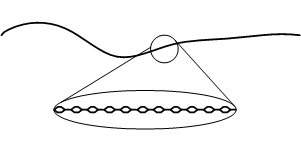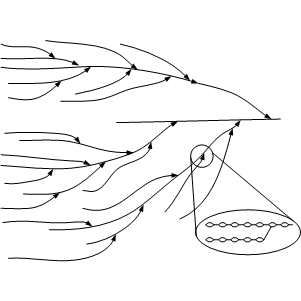(→Starch converting enzymes (Beta Amylase, Alpha Amylase, Limit Dextrinase)) |
(→Starch converting enzymes (Beta Amylase, Alpha Amylase, Limit Dextrinase)) |
||
| Line 23: | Line 23: | ||
If a single temperature rest for starch conversion is chosen, it needs to allow for sufficient beta and alpha amylase actitiy. This is given at temperatures between 140 *F (60 *C) and 160 *F (70 *C), but only temperatures between 148 *F (65 *C) and 158 *F (69 *C) are commonly used. The higher the temperature the lower the limit of attenuation (fermentability) of the resulting wort will be. The follwing is a table that lists the relation between temperature and fermentability [Narziss, 2005]: | If a single temperature rest for starch conversion is chosen, it needs to allow for sufficient beta and alpha amylase actitiy. This is given at temperatures between 140 *F (60 *C) and 160 *F (70 *C), but only temperatures between 148 *F (65 *C) and 158 *F (69 *C) are commonly used. The higher the temperature the lower the limit of attenuation (fermentability) of the resulting wort will be. The follwing is a table that lists the relation between temperature and fermentability [Narziss, 2005]: | ||
| − | {| | + | {|border='1' |
| − | |Temperature || 140 *F (60 *C) || 149 *F (65 *C) || 160 *F (70 *C) || 167 *F (75*C) | + | |Temperature || 140 *F (60 *C) || 149 *F (65 *C) || 160 *F (70 *C) || 167 *F (75*C) |
|- | |- | ||
|apparent limit of attenuation || 87.5% || 86.5 % || 76.8% || 54.0 % | |apparent limit of attenuation || 87.5% || 86.5 % || 76.8% || 54.0 % | ||
Revision as of 04:18, 12 February 2007
Mashing is the process in which the milled grain is mixed with water. This activates enzymes that were already present in the barley seed or have been formed during the malting process. These enzymes work best in particular temperature and pH ranges. By varying the temperature of the mash, the brewer has control over the enzyme activity. In essence, mashing needs to been seen as an extension of the malting process. The following sections describe the enzymes that are more or less important for the mashing process.
Contents
Starch converting enzymes (Beta Amylase, Alpha Amylase, Limit Dextrinase)
Starch conversion is the most important aspect of mashing. In barley starch makes up 63% - 65% of the dry weight. Brewer's yeast can only ferment monosacharides (glucose, ???), disacharides (maltose, ???) and trisacharides (matotriose, ???). The latter is only completely fermentable by lager yeas strains (s. uvarum). But the malt contains mainly starch which is a polysaccarid (very large chanis of glucose) that is insoluble in water.
In order for that starch to be converted into water soluble sugars (fermentable and unfermentable), two processes need to happen. First the starch is gelatenized to become water soluble. For starch found in barley and wheat malt this happens above 140 *F (60 *C). Other starches (rice for example) gelatinizes only above 194 *F (90 *C) and require boiling (see cereal mash) before they can be converted by enzymes. Secondly the amylase enzymes break the long chained starch into shorter chains.
The starch found in malt is composed from Amylose and Amylopectin. Amylase is a single chain of glucose molecules liked between their 1st and 4th carbon atom (called 1-4 link). 17-24% of barley starch is Amylose [Narziss, 2005] the remaining 76-83% is Amylopectin. Amylopectin has a branches structure. These branches are formed by bonds between the 1st and 6th carbon atom of 2 glucose rings (called 1-6 link).
Beta amylase produces Maltose, the main wort sugar, by splitting 2 glucose molecules from the non-reducing end of a glucose chain. It is therefore able to completely convert Amylose. But since it cannot get past the branch joins, Amylopectin cannot completely be converted by beta amylase. The optimal pH range for beta amylase between 5.4 and 5.6 and the optimal temperature range is between 140 *F (60 *C) and 150 *F (65 *C). Above 160 *F (70*C) beta amylase is quickly deactivated [Narziss, 2005].
Alpha Amylase is able to split 1-4 links within glucose chains. By doing so, it exposes additional non-reducing ends for the beta amylase. This allows for the further conversion of Amylopectin. The optimal pH range is between 5.6 and 5.8 and the optimal temperature range is between 162 *F (72 *C) and 167 *F (75 *C). Above 176 *F (80 *C) alpha amylase is quickly deactivated [Narziss, 2005]
Limit dextrinase is able to split the 1-6 links that are found in Amylopectin. It is therefore to reduce the amount of limit dextrins (glucose chains containing a 1-6 link) which are left over by alpha and beta amylase activity. Its optimal pH is 5.1 and the otimal temperature range is between 133 *F (55 *C) and 140 *F (60 *C). Above 149 *F (65 *C) this enzyme is quickly deactivated [Narziss 2005]. Because of a optimal temperature well below the commonly used saccrification rest temperature for single temperature saccrification rests, this enzyme plays only a mior role in most mashing schedules. Extended rests in the lower and upper 130s *F (upper 50s *C) benefit a higer fermentability of the wort.
During mashing the starch conversion to fermentable and unfermentable sugars is mostly done though beta and alpha amylase activities. After completed mashing the mash and the resulting wort need to test negative with iodine. This is the case for linear dextrines shorter than 9 glucose molecules and branched dextrines with less than 60 glucose molecules. The fermentability should match the targeted style of beer [Narziss, 2005].
If a single temperature rest for starch conversion is chosen, it needs to allow for sufficient beta and alpha amylase actitiy. This is given at temperatures between 140 *F (60 *C) and 160 *F (70 *C), but only temperatures between 148 *F (65 *C) and 158 *F (69 *C) are commonly used. The higher the temperature the lower the limit of attenuation (fermentability) of the resulting wort will be. The follwing is a table that lists the relation between temperature and fermentability [Narziss, 2005]:
| Temperature | 140 *F (60 *C) | 149 *F (65 *C) | 160 *F (70 *C) | 167 *F (75*C) |
| apparent limit of attenuation | 87.5% | 86.5 % | 76.8% | 54.0 % |
Protein converting enzymes (Peptidase)
Other Enzymes active during mashing
Glucanase
Phosphatase
Maltase
Sources
- [Narziss, 2005] Prof. Dr. agr. Ludwig Narziss, Prof. Dr.-Ing. habil. Werner Back, Technische Universitaet Muenchen (Fakultaet fuer Brauwesen, Weihenstephan), Abriss der Bierbrauerei. WILEY-VCH Verlags GmbH Weinheim Germany, 2005
- [Fix, 1999] George J. Fix Ph.D, Principles of Brewing Science, Brewers Publications, Boulder CO, 1999
- [foodnews.ch] http://www.foodnews.ch/x-plainmefood/index.html


